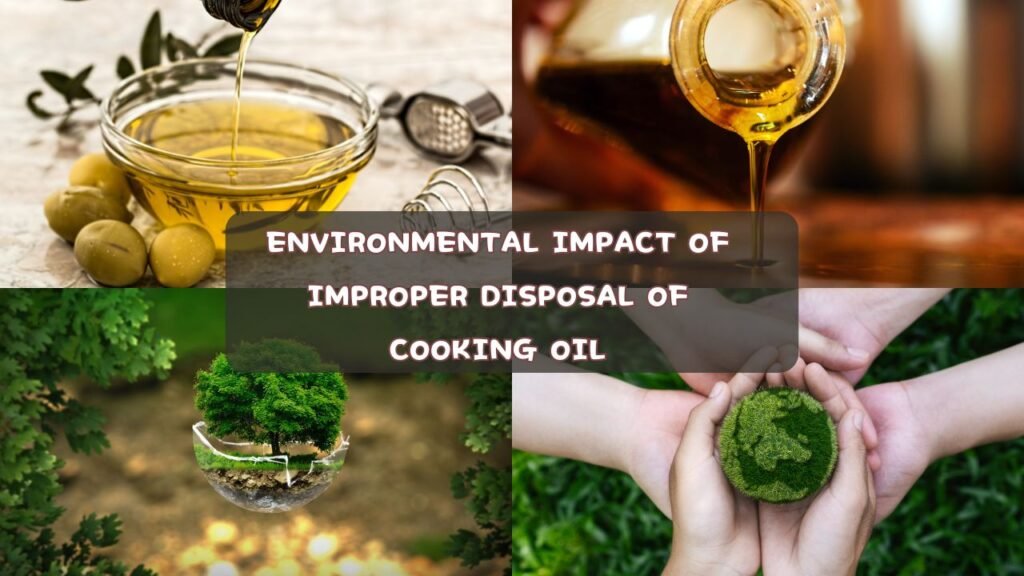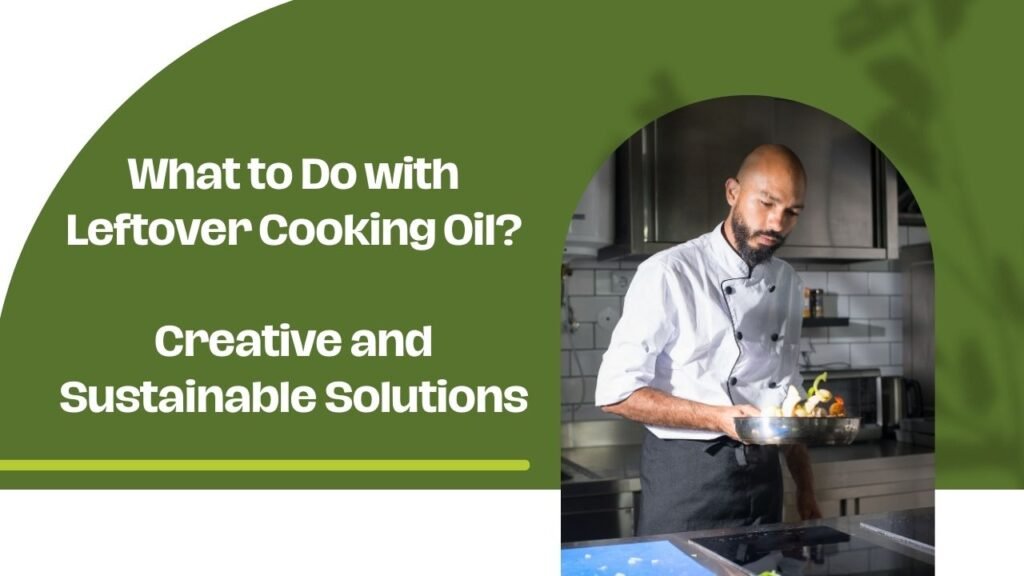Have you ever finished cooking a delicious meal only to be left with a pool of leftover cooking oil? Rather than tossing it in the trash, you might wonder, “What to do with leftover cooking oil?” You’re in luck! There are numerous creative, practical, and environmentally friendly ways to repurpose used cooking oil. Not only can you reduce waste, but you can also save money and even create something useful. Let’s explore the simple ways to reuse leftover cooking oil effectively.
Table of Contents
- Introduction to Leftover Cooking Oil
- Reusing Leftover Cooking Oil
- Repurposing Leftover Cooking Oil
- Proper Disposal of Cooking Oil
- Environmental Impact of Improper Disposal
- FAQs
- Conclusion
Introduction to Leftover Cooking Oil
Every time you cook with oil—whether frying, sautéing, or baking—you generate some leftover oil. Managing this surplus can seem daunting, but understanding what to do with leftover cooking oil can help you make informed, sustainable choices. Not only does proper handling reduce environmental impact, but it can also unlock a host of practical benefits in your daily life.
Why Manage Leftover Cooking Oil?
- Environmental Responsibility: Preventing oil from entering waterways helps protect aquatic life and ecosystems.
- Cost Savings: Reusing oil can extend its lifespan, reducing the need for frequent purchases.
- Household Efficiency: Utilizing oil in various household tasks can simplify your chores and projects.
But how exactly can you transform that used oil into something beneficial? Let’s dive into the myriad of possibilities.
Reusing Leftover Cooking Oil
One of the most straightforward approaches to handling leftover cooking oil is reusing it for future cooking endeavors. However, there are specific steps and considerations to ensure the oil remains safe and effective for reuse.
1. Recycle for Future Cooking
Reusing cooking oil is a sustainable practice that minimizes waste and saves money.
Steps to Reuse Cooking Oil:
- Cool the Oil: Allow the used oil to cool completely after cooking.
- Strain the Oil: Pour the oil through a fine mesh sieve or cheesecloth to remove food particles.
- Store Properly: Transfer the strained oil into a clean, airtight container. Glass jars or metal containers work best.
- Label and Date: Mark the container with the type of oil and the date it was stored.
- Store in a Cool, Dark Place: Keep the oil away from light and heat to prolong its shelf life.
Considerations:
- Oil Quality: Oil can only be reused a limited number of times before it degrades. Signs of degradation include a rancid smell, dark color, or excessive smoking.
- Type of Oil: Some oils, like olive and canola, are more stable for reuse compared to others like sesame or flaxseed oil.
- Cooking Method: Frying generates more impurities in the oil, which can reduce its reuse lifespan.

2. Make Homemade Seasoning or Dressings
Leftover cooking oil can be transformed into delicious homemade seasonings or salad dressings, enhancing your culinary creations.
Recipe Idea: Garlic Herb Infused Oil
Ingredients:
- 1 cup leftover cooking oil (e.g., olive oil)
- 3 cloves garlic, minced
- 1 tablespoon mixed dried herbs (e.g., thyme, rosemary, oregano)
- 1 teaspoon red pepper flakes (optional)
Instructions:
- Combine Ingredients: In a saucepan, combine the leftover oil, minced garlic, and dried herbs.
- Heat Gently: Warm the mixture over low heat for about 10 minutes, allowing the flavors to infuse without burning the garlic.
- Strain and Store: Remove from heat, strain out the solids, and transfer the infused oil to a clean bottle.
- Use as Desired: Drizzle over salads, roasted vegetables, or use as a dipping oil for bread.
3. Create Natural Cleaners
Used cooking oil can double as a natural, eco-friendly cleaner for various household items.
DIY Furniture Polish
Ingredients:
- 1/2 cup leftover cooking oil
- 1/4 cup white vinegar
- 10-15 drops essential oil (e.g., lemon, lavender)
Instructions:
- Mix Ingredients: In a spray bottle, combine the cooking oil and white vinegar.
- Add Scent: Add essential oils for a pleasant fragrance.
- Shake Well: Shake the bottle thoroughly before each use.
- Apply to Furniture: Spray a small amount onto a cloth and polish wooden furniture, countertops, or other surfaces.
Benefits:
- Non-Toxic: Safe for families and pets.
- Eco-Friendly: Reduces reliance on commercial cleaning products.
- Cost-Effective: Utilizes household items you already have.
Repurposing Leftover Cooking Oil
Beyond reuse in cooking, leftover cooking oil can be repurposed for a variety of creative and practical applications around the home.
1. DIY Beauty Products
Used cooking oil can serve as a base ingredient for several homemade beauty products, offering moisturizing benefits and cost savings.
Homemade Lip Balm
Ingredients:
- 2 tablespoons leftover cooking oil (e.g., coconut oil)
- 1 tablespoon beeswax pellets
- 10 drops essential oil (e.g., peppermint, vanilla)
Instructions:
- Melt Ingredients: In a double boiler, melt the beeswax and cooking oil together until fully combined.
- Add Scent: Remove from heat and stir in the essential oil.
- Pour into Containers: Pour the mixture into small containers or lip balm tubes.
- Cool and Store: Let the lip balm cool and solidify before use.
Benefits:
- Natural Ingredients: Avoids synthetic additives found in commercial products.
- Customizable: Choose your favorite scents and flavors.
- Cost-Effective: Saves money compared to store-bought options.
2. Lubricate Household Items
Leftover cooking oil can act as a natural lubricant for various household items, reducing wear and tear.
Example Uses:
- Hinges: Apply a small amount to squeaky door hinges to eliminate noise.
- – Locks: Lubricate door locks to ensure smooth operation.
- Tools: Prevent rust and keep tools in good working condition by wiping them with a thin layer of oil.
3. Craft Projects
Used cooking oil can be incorporated into various craft projects, adding a sustainable element to your creativity.
Candle Making
Ingredients:
- 1 cup leftover cooking oil
- 1/4 cup beeswax
- Wicks
- Essential oils (optional)
Instructions:
- Melt Beeswax and Oil: In a double boiler, melt the beeswax and cooking oil together until fully combined.
- Add Scent: Stir in essential oils if desired for fragrance.
- Prepare Containers: Place wicks in candle containers.
- Pour Mixture: Carefully pour the melted mixture into the containers, ensuring the wick stays centered.
- Cool and Set: Allow the candles to cool and harden completely before use.
Benefits:
- Eco-Friendly: Reuses kitchen waste in a creative way.
- Customizable: Create candles in various shapes, sizes, and scents.
- Cost-Effective: Reduces the need to purchase commercial candle-making supplies.
Proper Disposal of Cooking Oil
If reusing or repurposing leftover cooking oil isn’t feasible, proper disposal is crucial to prevent environmental harm and plumbing issues.
1. Solidify and Trash
One of the simplest methods for disposing of used cooking oil is to solidify it before throwing it away.
Steps:
- Cool the Oil: Let the oil cool completely after use.
- Contain the Oil: Pour the oil into a container that can be sealed, such as an empty milk carton or a plastic bottle.
- Solidify the Oil: Place the container in the refrigerator or freezer until the oil solidifies.
- Trash It: Once solid, dispose of the container in your regular trash.
Tips:
- Avoid Pouring Down the Drain: Cooking oil can clog pipes and harm the environment.
- Use Recyclable Containers: If possible, use containers that can be recycled to further reduce waste.
2. Composting Considerations
While some small amounts of cooking oil can be composted, it’s generally not recommended due to potential issues with pests and odor.
Guidelines:
- Limited Quantity: Only compost minimal amounts of oil, if at all.
- Mix Thoroughly: Ensure the oil is well mixed with other compost materials to prevent clumping and odor.
- Monitor Compost Pile: Keep an eye on your compost pile to manage any potential problems caused by adding oil.

Environmental Impact of Improper Disposal
Improper disposal of cooking oil can have significant environmental consequences. Pouring oil down the drain can lead to clogged pipes and sewage system issues. Additionally, oil that enters waterways can harm aquatic life, disrupt ecosystems, and contribute to pollution.
Key Points:
- Water Pollution: Oil can form a film on water surfaces, reducing oxygen levels and harming marine organisms.
- Soil Contamination: Oil can seep into the soil, affecting plant growth and soil health.
- Waste Management Strain: Large quantities of oil can overload waste management systems, leading to increased costs and environmental strain.
By choosing to reuse, repurpose, or properly dispose of leftover cooking oil, you play a vital role in protecting the environment and maintaining a sustainable household.
FAQs
1. Can I Pour Cooking Oil Down the Drain?
No, pouring cooking oil down the drain can lead to clogged pipes and environmental pollution. It’s best to reuse, repurpose, or dispose of it properly.
2. How Long Can I Store Used Cooking Oil for Reuse?
Used cooking oil can typically be stored for up to a month if kept in a cool, dark place. Always check for signs of spoilage, such as a rancid smell or dark color, before reuse.
3. Is It Safe to Reuse Cooking Oil for Multiple Frying Sessions?
Yes, but with caution. Reusing oil for frying is safe as long as the oil hasn’t degraded. Strain it to remove food particles and store it properly. However, avoid reusing oil more than 2-3 times to maintain quality and safety.
4. Can I Compost Cooking Oil?
While small amounts can be composted, it’s generally not recommended due to the risk of attracting pests and creating unpleasant odors. If you choose to compost, do so sparingly and mix thoroughly with other compost materials.
5. What Are the Best Containers for Storing Used Cooking Oil?
Glass jars, metal containers, or any airtight, non-reactive containers are ideal for storing used cooking oil. Ensure they are clean and dry before use.
6. How Can I Prevent Excess Cooking Oil Leftover?
- Measure Carefully: Use only the amount of oil needed for your cooking.
- Use Non-Stick Cookware: Reduces the amount of oil required for cooking.
- Opt for Healthier Cooking Methods: Baking, steaming, or grilling often require less oil.
7. Are There Any Health Risks Associated with Reusing Cooking Oil?
Reusing cooking oil beyond its safe limit can lead to the formation of harmful compounds and free radicals, which may pose health risks. Always monitor the oil’s quality and avoid using it if it shows signs of degradation.
Conclusion
So, what to do with leftover cooking oil? The possibilities are vast and varied, ranging from practical kitchen solutions to creative household projects. By choosing to reuse, repurpose, or properly dispose of your used cooking oil, you contribute to a more sustainable environment and make the most out of your culinary efforts.
Whether you decide to recycle the oil for future cooking, create natural cleaners, craft beauty products, or explore other repurposing methods, there’s a solution that fits your lifestyle and values. And if repurposing isn’t feasible, ensuring proper disposal prevents environmental harm and maintains household plumbing integrity.
Next time you’re faced with leftover cooking oil, don’t rush to throw it away. Instead, consider these eco-friendly and innovative options that not only reduce waste but also add value to your daily routines. After all, sustainability starts with small, mindful actions that collectively make a significant impact.
Remember, managing leftover cooking oil is not just about avoiding waste—it’s about embracing creativity, fostering environmental responsibility, and enhancing your household efficiency. So, the next time you finish cooking, ask yourself, “What to do with leftover cooking oil?” and choose a path that aligns with your sustainable living goals.


